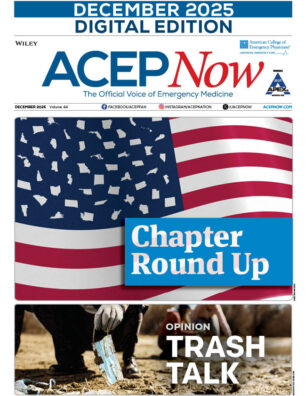
The clinical policy on the management of adult patients presenting to the emergency department (ED) with acute ischemic stroke, was approved by the ACEP Board of Directors in April 2023.
Explore This Issue
ACEP Now: Vol 43 – No 05 – May 2024Developed by the ACEP Clinical Policies Committee, the guidance was published in the August 2023 issue of the Annals of Emergency Medicine. You can find it on ACEP’s website, www.acep.org/clincialpolicies, as well as in the ECRI Guidelines Trust.
Approximately 800,000 people in the United States are diagnosed with a stroke each year at an estimated cost of approximately 46 billion dollars. As a result, stroke remains one of the leading causes of death, as well as the leading cause of disability. Nearly 30 percent of all patients with an acute ischemic stroke have a large vessel occlusions (LVO), whereas 12 percent of acute stroke patients are thought to be candidates for endovascular thrombectomy (EVT). Because timely access to the expertise and resources needed to perform EVT is limited for much of the U.S. population, question one examines the use of out-of-hospital decision aids to assist in identifying suspected LVO patients who may be candidates for EVT.
Diagnosing an acute stroke patient with an LVO who may be a candidate for EVT requires advanced imaging, such as computed tomography angiography (CTA). However, identifying which suspected stroke patients are likely to have an LVO can be challenging. This has implications for determining who should receive advanced imaging, such as a CTA, in the ED or potentially be diverted to an EVT-capable stroke center. Question two examines the addition of computed tomography perfusion (CTP) to CTA or MRA to identify patients more likely to benefit from thrombectomy.
Recently, there has been interest in the use of tenecteplase for acute ischemic stroke. Question three compares the published literature comparing the safety and effectiveness of tenecteplase versus alteplase.
Finally, patients who present with dizziness can present a diagnostic challenge to emergency physicians trying to differentiate a peripheral from a central cause. Although the rate of misdiagnosis of stroke in patients who are discharged home from the ED with a diagnosis of peripheral vertigo is less than 0.2 percent, up to 37 percent of posterior circulation strokes are missed on initial presentation. Because the mortality of a missed posterior circulation stroke can be significantly higher than those with cerebellar strokes in general, Question four examines the strategies that are needed to prevent misdiagnosis.
The critical questions were based on feedback from ACEP members. A systematic review of the evidence was conducted and the committee made recommendations (Level A, B, or C) based on the strength of evidence available. This clinical policy underwent internal and external expert review and was available for review by ACEP members during an open comment period. Responses received were used to refine and enhance the final policy.
Critical Questions and Recommendations
Question 1: In adult patients with a suspected acute ischemic stroke, can a clinical decision instrument be used to identify patients who have an LVO on CTA or MRA?
Patient Management Recommendations
- Level A recommendations: None specified.
- Level B recommendations: None specified.
- Level C recommendations: In adult patients with suspected stroke, either the Los Angeles Motor Scale (LAMS) or Rapid Arterial Occlusion Evaluation Scale (RACE) may be used to identify patients with increased likelihood of an LVO.
Question 2: In adult patients with a suspected acute ischemic stroke, does the addition of perfusion imaging to a CTA or MRA identify patients more likely to benefit from thrombectomy?
Patient Management Recommendations
- Level A recommendations: None specified.
- Level B recommendations: None specified.
- Level C recommendations: Obtain CTP or MR-based diffusion/perfusion imaging in patients with acute ischemic stroke because of LVO, especially if the time the patient was last known normal was between 6 and 24 hours before arrival to the ED.
Question 3: In adult patients with a suspected acute ischemic stroke qualifying for intravenous thrombolysis, is tenecteplase safe and effective compared with alteplase?
Patient Management Recommendations
- Level A recommendations: None specified.
- Level B recommendations: Use either tenecteplase or alteplase in patients with acute ischemic stroke who qualify for thrombolysis.*
- Level C recommendations: None specified.
*For tenecteplase, use 0.25 mg/kg maximum dose 25 mg bolus; for alteplase, use 0.9 mg/kg maximum dose 90 mg with 10 percent given as a bolus and the remaining as an infusion over 60 minutes.
Question 4: In adult patients who present with acute vertigo with possible stroke, is there a history or physical examination findings (e.g., HINTS examination) that can risk stratify for acute ischemic stroke?
Patient Management Recommendations
- Level A recommendations: None specified.
- Level B recommendations: None specified.
- Level C recommendations: In addition to a standard comprehensive history and physical examination, physicians may use specific findings such as ABCD2 score, ocular motor examination, presence of additional neurologic deficits, and HINTS to risk stratify patients with a possible stroke. Before employing a maneuver such as HINTS, physicians should have sufficient education to perform the technique (Consensus recommendation).
 Dr. Lo is chief of the department of emergency medicine in Sentara Hospitals Norfolk and medical director of Sentara Transfer Center as well as professor/assistant program director Eastern Virginia Medical School in Norfolk, VA.
Dr. Lo is chief of the department of emergency medicine in Sentara Hospitals Norfolk and medical director of Sentara Transfer Center as well as professor/assistant program director Eastern Virginia Medical School in Norfolk, VA.
Pages: 1 2 3 | Multi-Page





No Responses to “ACEP’s Clinical Policy on Acute Ischemic Stroke”